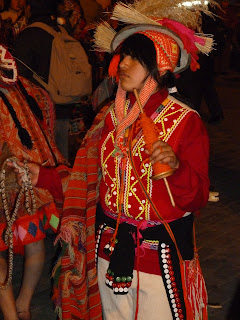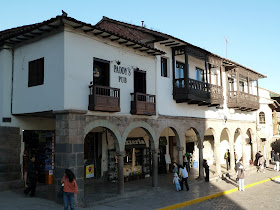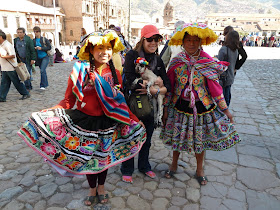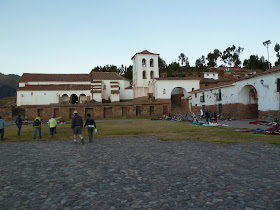 |
| Cusco in it's valley at 11,200 ft |
Left: An example of the terrain. This must have been a relatively low bit because some of the places we passed had snow on the top. As I said, the photograph does not adequately convey the enormous vertical scale. The camera flattens it out a bit. Like most of the pics I took up in the Andes, every time I thought I saw an unbeatably dramatic panorama another more startling one appeared around the corner.
Right: The Plaza de Armas, main square. I've discovered why all Peruvian towns/cities have Plazas de Armas. It's to do with the Spanish conquistadors basing there soldiers in the town centres and having their HQs there.
On arrival in the outskirts of Cusco, 1.30 pm, the first thing I noticed, as around Lima, was the grey dust which seemed to cover everything. The second thing was the lack of oxygen. The town is 11,200 ft up and it felt like it. Any effort resulted in breathlessness and feeling a bit lightheaded. I was told you got used to it. It also gets very cold when the sun goes down.
Left: Another part of the main square. There were several squares. The town centre was relatively dust-free, clean and jolly. It is the most touristy place in Peru and also ( on June 24th ) due to celebrate the 100th anniversary of something. I was warned to expect it to be packed out with tourists. It wasn't really, and not too crowded. Busy perhaps. There was an extraordinary profusion of 'money exchanges' and 'massage parlours', on the scale of shoe shops in Lima. I had been warned of a spate of fake banknotes, so anyone getting money from a street-side exchange was courting disaster. I suspect the 'massages' might also have held risks.
 Every afternoon and evening there were noisy processions of ever more colourful and exotic bands and groups of dancers parading up the streets and around the main square, mostly schoolchildren. Lots of firecrackers too. The bands, and dancing, were notable for their exuberance, if not for their artistic precision. Everybody was enjoying themselves and they were supported and cheered on by an enthusiastic crowd of onlookers. They never seemed to stop. They were, unlike me puffing like a leaking boiler, acclimatised to the altitude.
Every afternoon and evening there were noisy processions of ever more colourful and exotic bands and groups of dancers parading up the streets and around the main square, mostly schoolchildren. Lots of firecrackers too. The bands, and dancing, were notable for their exuberance, if not for their artistic precision. Everybody was enjoying themselves and they were supported and cheered on by an enthusiastic crowd of onlookers. They never seemed to stop. They were, unlike me puffing like a leaking boiler, acclimatised to the altitude.Left: Another bit of the never ending parades. I liked the Quechuan woman with her authentic traditional mobile-phone.
Right: A creature of the night. I think they started to go to bed around 11.00 pm. Well past my bedtime.
Left: Another colourful performer.
Right: OK. I'll get it over with. The mandatory Oirish bear. I never did meet Paddy, but this place was an excellent watering-hole. It was full, of an evening, with us 'foreigners'. They did a very good shepherds pie and Irish stew. And Guiness.
Left: Self explanatory.

Right: Inside. The TVs were showing rugby when I first went in. Wales v. Argentina. This was the most genuine looking and feeling 'pub' I have been in outside Ireland or UK. It changed somewhat on the Sunday night before I left when the place was invaded by a pack of Americans who insisted on watching one of their 'netball' matches.
Left: This is the Cusco 'rainbow' flag. It is proudly flown all over the town. As you can see it bears a striking, and unfortunate, resemblance to that adopted by the so-called 'Gay Pride' movement. I suspect that there have probably been some nasty 'misunderstandings' involving our more limp-wristed brethren and the local Quechuan population who are not notably tolerant towards those sort of 'strange practices'.
Right: All over the town there were girls and women dressed up in the Quechua costume carrying or dragging their livestock to provide a 'photo-opportunity' for us tourists, and to expect a few 'sol' for the priviledge.
There are 3 sol to the dollar.
Left: More locals with their alpacas, and friend. Actually the women folk always wear their traditional rig regardless of tourists. It is normal day wear for them. All their kit is carried in the ponchos over their shoulders. Without exception all Quechua women wear hats. The hat is an indication of which community they come from. The team colours. Like camels, to which they are related, alpacas can spit at you. Filthy beasts.
Cusco ( Cos'quo in Quechuan ) was Inca HQ between 1430 and 1536. It had some imposing buildings which the Spanish proceded to plunder and wreck. I went on a couple of excellent tours, most profesionally organised, of the city and the so-called 'Sacred Valley' to the west leading to Machu Picchu. The Incas did not tend to live in towns, they lived up the mountains in scattered small settlements. The low flat ground was kept for agriculture, and maybe the odd palace. One of their great skills was building and architecture, much wrecked by Senor Francisco Pizarro and his boys after 1536.
Right: One of their stone walls. They all leaned slightly inwards and were most effective in resisting earthquakes. The stones were beautifully cut and polished with no cement. The corners were curved and it was impossible to get even a piece of paper between the stones.
We were shown around various churches which had been built over Inca ruins by the Spanish. They somehow managed to combine Roman Catholic and local religion. The central cathedral contained massive amounts of gold leaf, silver ornaments and colossal portraits ( who paid for all this ). A vast amount of heavy silverware was piled on a covered truck to be paraded around the town on special occasions. The Incas worshipped natural phenomena, especially mountains, sun and moon. Their gods, abu, live in the mountains. As a result the virgin Mary is portrayed in pictures in the shape of a mountain! Not very flattering. An enormous picture of the 'Last Supper' featured, as the central dish, a fat roast guinea-pig ( which is still a much enjoyed delicacy ). No photos allowed in churches.
Left: Our city guide, Puma Sonquo, who is a native Quechuan. He was very knowledgeable and had a wicked sense of humour. He made it clear that the Quechua people are still a proud nation in these parts and are the predominant people in the mountains. He is of typical build, short and stocky with a broad chest ( big lungs for living at altitude ). He is standing in front of the ruins of an important Inca religious site called Saqsayhuaman ( pronounced sexy woman ). It is the ultimate example of dry stone walling using some mammoth carved stone.
Right: A better pic of Saqsayhuaman. Understanding the Inca civilisation and what all their magnificent constructions were for, and how they developed the expertise that went into making them sufferes from a major drawback. The Incas, unlike the Maya, left no writing. They used the form of record involving knotted and beaded lengths of string. I can't remember what it's called. So, any 'authoritative' description of what they were up to is, more or less, conjecture. Even the tour guides admitted that most of their marvellous graphic descriptions were based on guesswork.
Left: This was another church at the village of Chinchero, up at 12,000 ft. It was a good example of a building with Inca stonework at the bottom and Spanish constuction on top. This was part of a tour up the Sacred Valley leading west towards Machu Picchu. The altitude of the valley floor ranged from about 10,000 ft to 12,500 ft which made climbing up hillsides and, often, lots of steps quite hard work. We were fed coca leaves and coca tea which apparently helps one cope with altitude. I discovered that if you chew too much of it your tongue goes numb, and who cares about the altitude!
Right: Looking down on the village of Pisaq.We were encouraged to visit the old market there. As with everywhere we went we were given the hard sell for local handicrafts. Hats, woven things, jewellery etc. etc. There was so much stuff on offer and not much seemed to get sold.
The snow capped mountain in the background is Mt Veronica at about 18,000 ft. The highest in the neighbourhood is Mt Ausangate at 21,000 ft.
Left: Up above the villages are old Inca settlements which farmed using terraces. Actually, many of
the terraces were built well before the Inca era, and are still used today. Many crops of cereal and fruit are grown. The villages are self-supporting for food. We were told that much of this farming involved 'two bears' which seemed strange. She meant tubers. I presume you know that potatoes originated in Peru, and they claim to have 4000 varieties. They take their spuds very seriously. They also have 200 varieties of corn. One such is the 'black' corn. It's purple really and they make a popular soft drink from it called Chicha Morales.
Right: Some black corn and the chicha morales drink. It's quite pleasant and tastes a bit like blackcurrent juice. It has great promise as the base for a new lethal cocktail....Inca Death perhaps, or Andes Assassin. I'm working on it. It could become a rival for the national cocktail Pisco Sour, details of which will follow at some point.
Left: A herd of alpaca for sale at the market in Pisaq. So much there and so little sold. Lots of clothes made from '100% baby alpaca' were always being touted. We were told that the other unsung animal hero in the area was the timid and rarely seen acrylic which lent a lot of it's wool to supplement the hard pressed alpaca.
Right: This guy was making industrial quantities of bread for about six admiring tourists. It was actually rather good. He liberally dished it out to us. We thought it was free, but he remembered to give us the bill before we left.
Left: A young lad blowing his flute at about 12,000 ft at the ruins of an old Inca village above Pisaq. We had climbed up god knows how far to get there. I most certainy would not have been able to blow a match out, let alone a flute.
Right: Some of the terraces. I don't think I would volunteer to work the tractor on that. There is a drop of about a thousand feet off the bottom edge.
Left: Steps ( 250 ) up to an Inca temple at Ollantaytambo. This was another impressive bit of construction although our guide could only guess as to the purpose of it all. If all else fails they resort to some religious or astronomical function. It can't be proved wrong. A couple were holding their wedding here. The bride wore stout boots.
Right: Just another example here of the extraordinary 'stonework' that they were renowned for. Lots of angles which all fitted together with the utmost precision. Five of the stones at the top weighed over 30 tons each and were assembled to form a giant temple wall. They had been carried for 5 miles from a neighbouring mountain and somehow dragged up sloping ramps to the top of this edifice. What extraordinary efforts these people went to for whatever purpose.
Left: These were supposedly storehouses for food. They were build on a near vertical cliff about 500 feet above the houses. It was thought that the wind going through the ventilation holes kept the food cool and fresh. Also stopped people sneeking out at night to raid the fridge, or equivalent.
Left: These lovely ladies were giving us a demonstration of how they wove their '100% baby alpaca' wool into magnificent shawls and things. The dying process was quite interesting and involved plants and crushed insects together with children's urine and probably eye of newt and toe of frog as well. They had a large cage full of guinea-pigs in the corner of the room which, I am sure, were not the children's pets.
Left: One of the many Quechua urchins who wandered around trying to sell chocolate, cigarettes, finger puppets, chewing gum and other cheap tat to tourists. If you were eating outside at a restaurant you were particularly vulnerable. They were nothing if not persistent, and actually quite amusing. This girl, aged about eight, when I told her for the tenth time that I didn't have any money said ''that's OK, we take Visa, Mastercard and American Express''.
Looking forward to the train ride to Aguas Calientes and thence up to Machu Picchu. Report to follow.
Just checking in!



























Not too many comments have been appearing lately so thought I'd let you know I for one am still eagerly following your adventures. There must be really good internet facilities along the way.
ReplyDeleteTomorrow I'm off to England and Holland for a month and from past experience wifi for my laptop was often hard to track down, so may have to wait till back in Canada to catch up on Machu Picchu. Happy travelling!
Inka Tours at Peru offers guided journeys through the heart of the Andes,
ReplyDeleteshowcasing ancient Inca trails, vibrant culture, and breathtaking landscapes.
Their tours provide an authentic experience of Peru’s rich history and natural wonders.